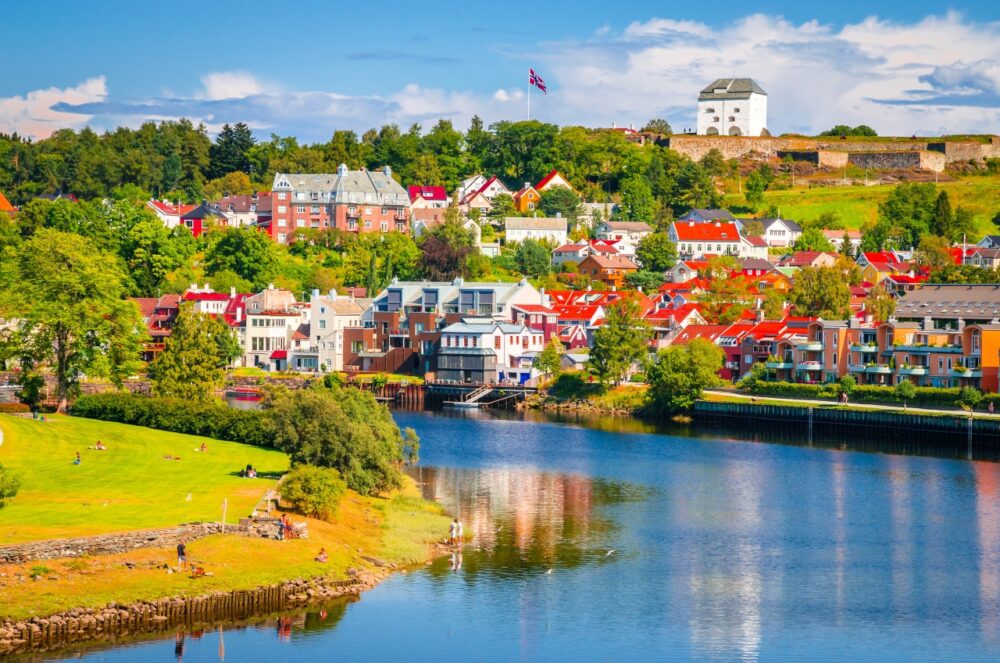
Is Trondheim worth visiting? Absolutely! When I first arrived in Trondheim, I was immediately taken by its cosy yet vibrant atmosphere. Walking along the colourful wooden wharves by the Nidelva River and exploring the stunning Nidaros Cathedral, it was clear that this city had a unique charm. Trondheim is a place where history and modern Scandinavian cool collide, creating a destination that feels both rich in heritage and refreshingly innovative.
Located in central Norway, Trondheim is a city with deep historical roots—it was once the Viking capital of Norway and a major pilgrimage site. Today, it’s a lively university town with a youthful energy, surrounded by breathtaking natural beauty. From its bustling food scene and quaint Bakklandet neighbourhood to its impressive cultural landmarks, Trondheim has something for every traveller. Whether you’re hiking in the surrounding fjords, cycling along its scenic waterfront, or discovering the fascinating stories of its past, Trondheim is a city that deserves a spot on your itinerary.
But is Trondheim worth visiting for you? In this blog post, we’ll uncover the top 10 reasons why Trondheim should be on your travel list, from its historical highlights to its outdoor adventures. Plus, we’ll share practical travel tips to help you make the most of your time in this Norwegian gem. Keep reading to discover why Trondheim is more than just a stop on the map—it’s a destination to fall in love with.
Table of Contents
Pros – Reasons You Should Visit Trondheim
1. A Beautiful and Walkable City with a Relaxed Atmosphere
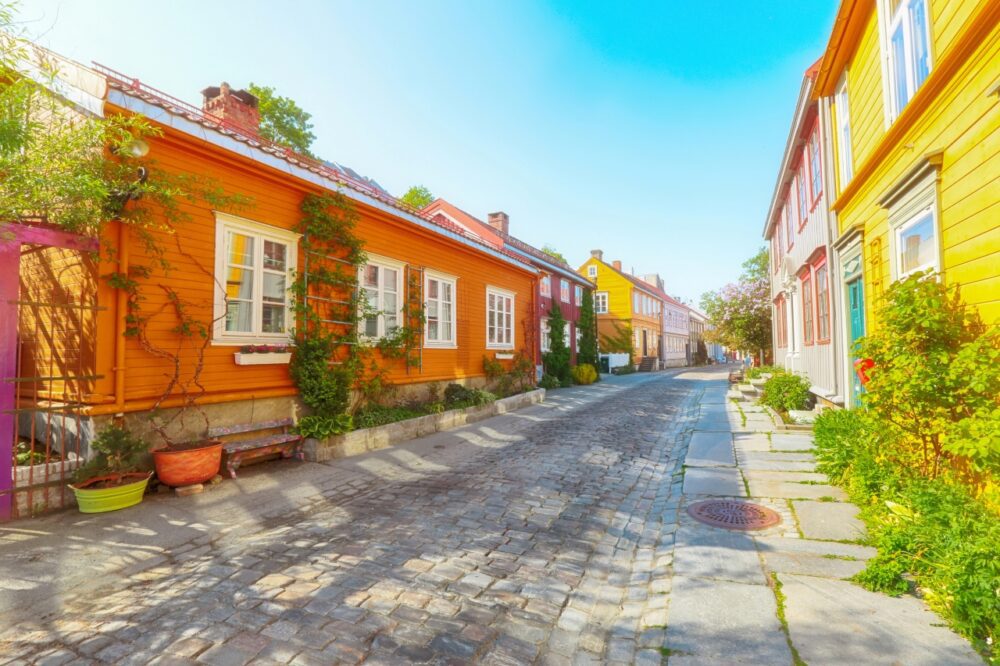
Trondheim is one of Norway’s most charming cities, with colorful wooden houses, scenic waterfront views, and a relaxed, small-town feel despite being the country’s third-largest city. Unlike busier destinations like Oslo or Bergen, Trondheim has a laid-back atmosphere that makes it a pleasure to explore on foot.
I spent a morning strolling through the cobbled streets of Bakklandet, a historic district filled with charming cafés, independent boutiques, and pastel-colored wooden homes. The lack of heavy traffic and crowds made wandering through the city feel peaceful, and every turn revealed another picture-perfect street or scenic bridge over the Nidelva River. Trondheim’s walkability and slower pace make it a perfect destination for those looking to enjoy Norway without the rush.
2. Nidaros Cathedral is One of the Most Impressive Churches in Scandinavia
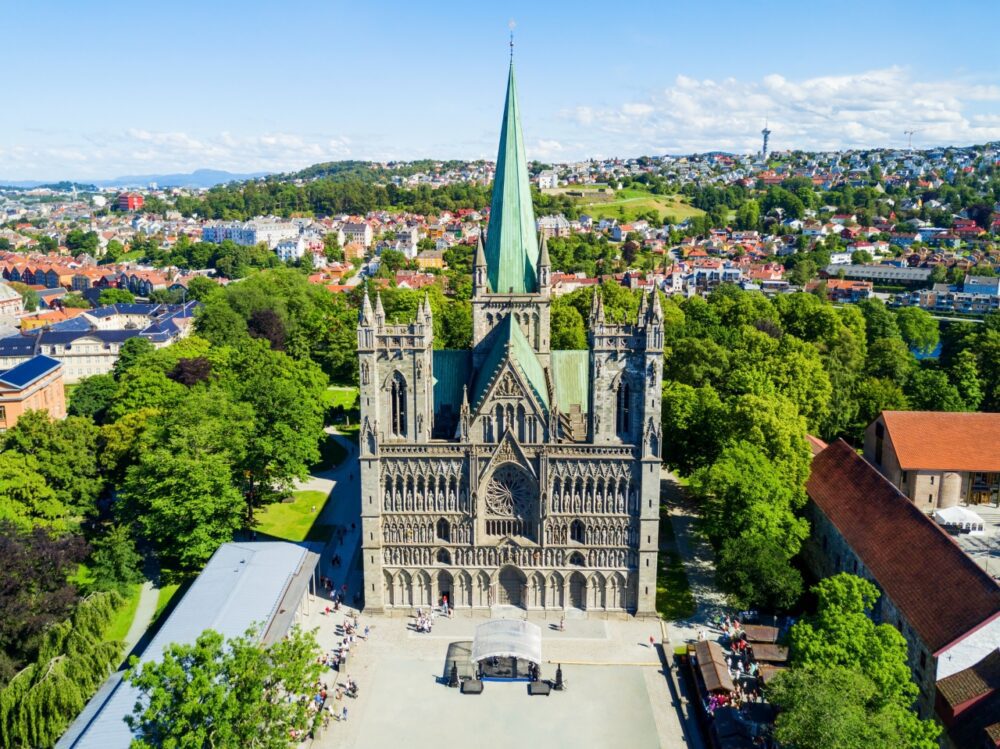
Nidaros Cathedral is Trondheim’s most famous landmark and one of the most stunning examples of Gothic architecture in Scandinavia. Built over the tomb of Saint Olaf, Norway’s patron saint, it has been a pilgrimage site for centuries and remains one of the country’s most important religious buildings.
I was immediately struck by the intricate details of the cathedral’s façade, covered in beautifully carved statues and decorations. Inside, the towering stone arches and stained-glass windows created a dramatic yet peaceful atmosphere. Climbing the narrow spiral staircase to the top of the tower provided an incredible panoramic view of Trondheim, making the visit even more memorable. Whether or not you’re religious, Nidaros Cathedral is a must-see for its history, architecture, and breathtaking presence.
3. The Colorful Wharf Houses Along the Nidelva River
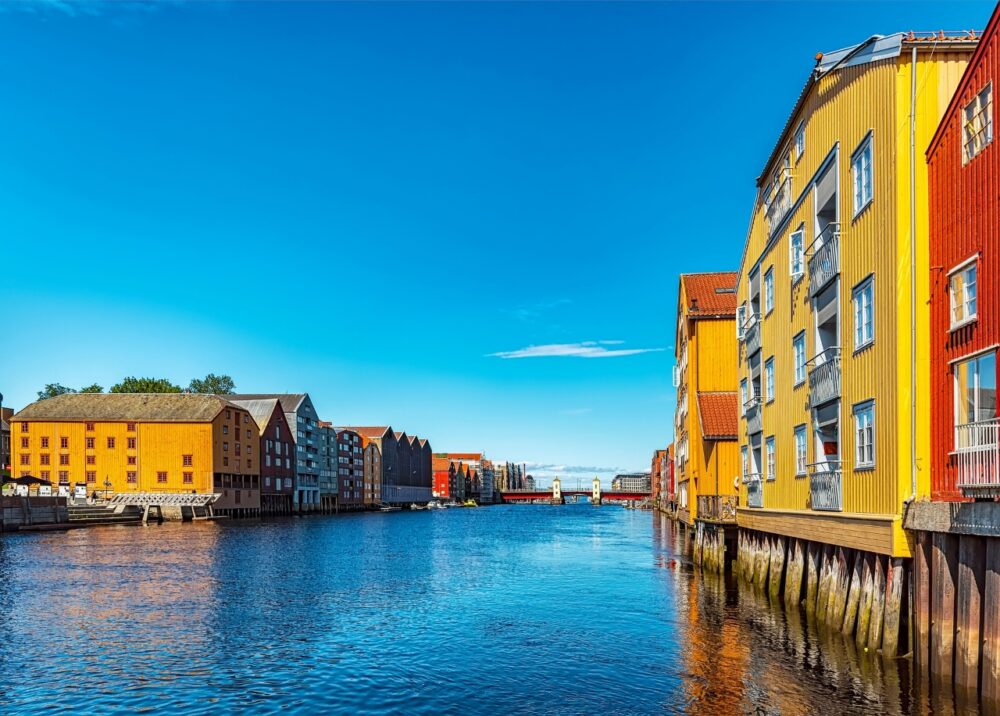
Trondheim’s iconic wharf buildings, known as Bryggene, line the Nidelva River and add to the city’s postcard-perfect charm. These colorful wooden warehouses, once used for storage and trade, have been transformed into shops, cafés, and apartments while maintaining their historic character.
I took a walk across the Old Town Bridge, where the view of the red, yellow, and green buildings reflecting in the water was stunning. The area is particularly beautiful in the early morning or at sunset when the light makes the colors even more vibrant. Whether you admire them from the bridge, take a boat ride along the river, or explore the small alleyways between them, the wharf houses give Trondheim a unique and picturesque identity.
4. A Rich Viking History and Fascinating Museums
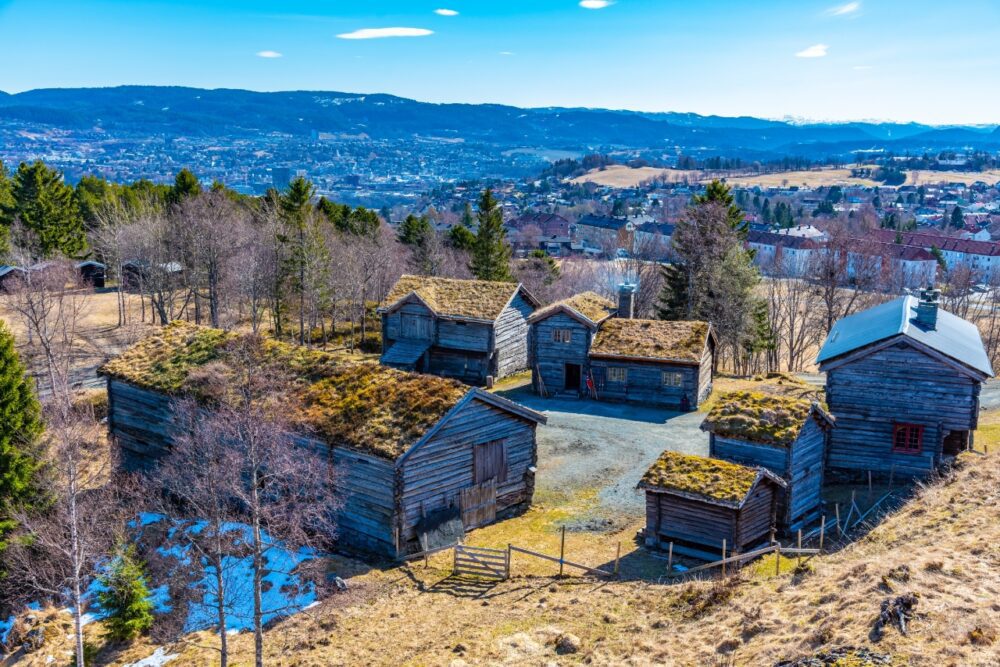
Trondheim has a deep connection to Viking history, having been founded as Norway’s first capital in the year 997 by King Olaf Tryggvason. Today, the city is home to several excellent museums that bring its Viking past to life.
I visited the Archbishop’s Palace Museum, where I saw impressive medieval artifacts, including Norway’s crown jewels and ancient weaponry. Another highlight was the Sverresborg Trøndelag Folk Museum, an open-air museum with reconstructed Viking-era buildings and exhibits on Trondheim’s history. If you’re interested in Norse culture and medieval history, Trondheim offers plenty of ways to explore Norway’s past.
5. A Thriving Food Scene with Local Specialties
Trondheim has earned a reputation as one of Norway’s top food cities, with a strong focus on locally sourced ingredients and traditional Norwegian flavors. From fresh seafood to reindeer meat, the city’s restaurants celebrate the best of Norwegian cuisine with a modern twist.
I tried klippfisk (dried and salted cod) at a waterfront restaurant, and the rich, savory flavors paired perfectly with a glass of local beer. Another must-try dish is raspeballer, Norwegian potato dumplings often served with lamb and lingonberries. The city’s cafés also serve excellent cinnamon buns, known as kanelsnurrer, which were the perfect treat with a hot cup of coffee on a chilly day. Trondheim is a fantastic place to experience authentic Nordic flavors.
6. Bymarka Offers Fantastic Hiking and Outdoor Activities
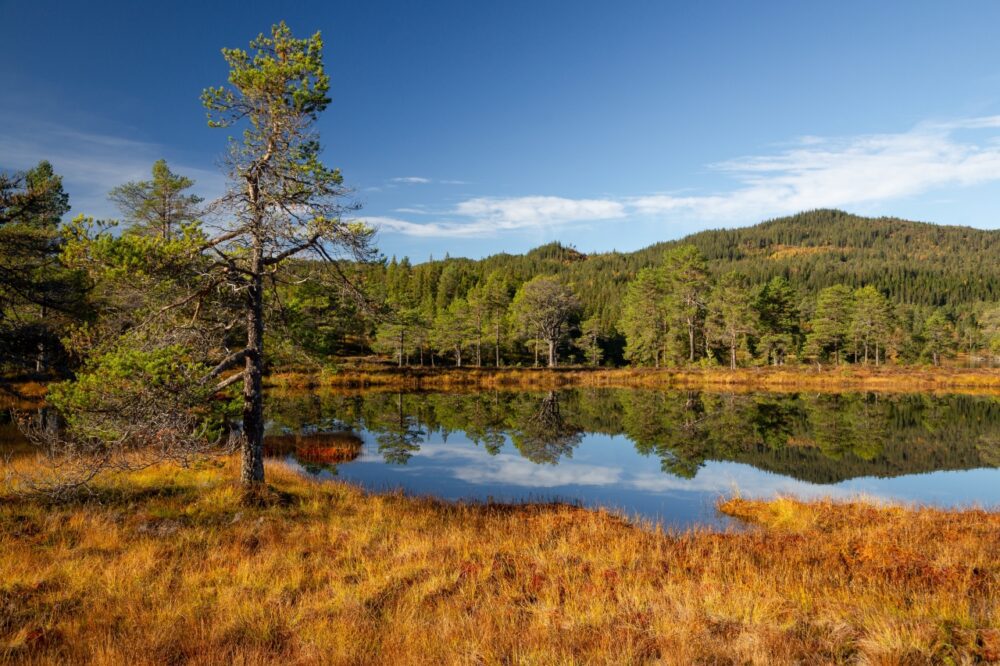
Just outside the city center, Bymarka is Trondheim’s natural playground, offering forests, lakes, and hiking trails that are perfect for outdoor enthusiasts. Whether you enjoy walking, cycling, or skiing in the winter, this vast nature reserve is a great way to experience Norway’s wilderness without traveling far.
I spent an afternoon hiking through Bymarka’s scenic trails, stopping at a small lake to enjoy the peaceful surroundings. The fresh air, lush greenery, and well-marked paths made it an ideal escape from the city. If you visit in winter, the area transforms into a cross-country skiing paradise, with miles of groomed trails through snow-covered forests.
7. Trondheim is Less Touristy Than Other Norwegian Cities
While Bergen and Oslo attract large numbers of tourists, Trondheim remains a bit of a hidden gem. This means you can explore its historic sites, scenic streets, and waterfront areas without battling huge crowds, making for a much more relaxed and enjoyable visit.
I loved how easy it was to find a quiet spot along the river or enjoy a meal without needing a reservation weeks in advance. Even at major attractions like Nidaros Cathedral, there was never a sense of being overwhelmed by tourists. If you want to experience Norway without the usual crowds, Trondheim is a perfect choice.
8. The Midnight Sun in Summer and Northern Lights in Winter
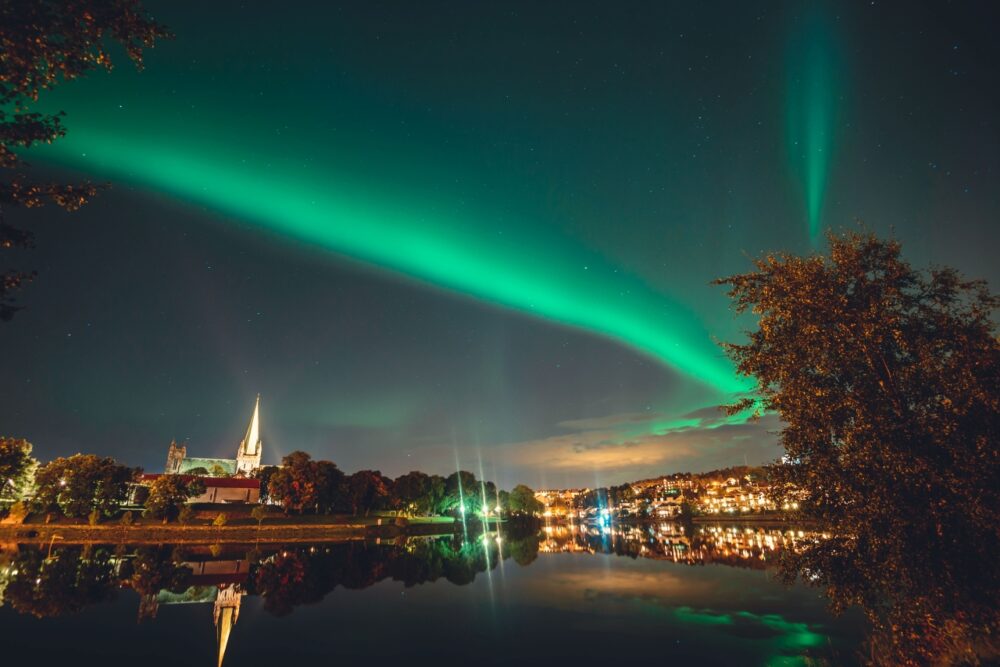
Trondheim offers incredible natural phenomena depending on the season. In summer, the long daylight hours mean you can enjoy outdoor activities late into the evening, while in winter, there’s a chance to see the northern lights dancing over the city.
I visited in June and was amazed at how bright it stayed, even at midnight. Sitting by the river, watching the golden glow of the sun linger on the horizon, was a surreal and magical experience. If you visit in winter, heading just outside the city gives you a great chance of spotting the aurora borealis on clear nights.
9. The World’s Only Bicycle Lift is in Trondheim
For something truly unique, Trondheim is home to the world’s only bicycle lift, the Trampe. Designed to help cyclists reach the top of the steep Brubakken Hill, this quirky invention has become a fun attraction in itself.
I watched locals effortlessly glide up the hill by placing their foot on the lift’s moving platform, which pushed them smoothly to the top. While I didn’t try it myself, it was entertaining to see how a small city like Trondheim embraces creativity and cycling culture in such a playful way.
10. A Perfect Blend of History, Nature, and Modern Life
Trondheim strikes a perfect balance between historic charm, stunning natural surroundings, and modern conveniences. It has all the beauty and history of a European heritage city, combined with the clean, organized, and forward-thinking lifestyle that Norway is known for.
Whether I was admiring centuries-old churches, hiking in the nearby forests, or enjoying great food in a stylish café, Trondheim felt like a city that had something for everyone. It’s small enough to feel cozy and welcoming but big enough to offer plenty of things to do, making it a fantastic destination for any type of traveler.
Cons – Things to Consider When Visiting Trondheim
1. Trondheim Can Be Expensive, Like the Rest of Norway
Norway is one of the most expensive countries in the world, and Trondheim is no exception. Accommodation, dining, and everyday expenses can quickly add up, making it a costly destination for budget travelers. While it’s slightly more affordable than Oslo or Bergen, prices for food, drinks, and activities are still high compared to most other European cities.
I stopped at a casual café for lunch and was surprised when a simple sandwich and coffee cost nearly as much as a full meal in other parts of Europe. Restaurant dining, in particular, can be expensive, with even mid-range meals easily reaching €30 or more. While there are ways to save—such as buying groceries and eating at bakeries—travelers should be prepared for high costs throughout their stay.
2. The Weather is Unpredictable and Can Be Cold Even in Summer
Trondheim’s northern location means that the weather can be unpredictable and colder than you might expect, even during the summer months. While the long daylight hours in summer are a major draw, temperatures can still be quite cool, and sudden rain showers are common. Winters are dark and cold, with snow and ice making travel more challenging.
I visited in June and expected mild weather, but I found myself layering up with a jacket as the temperature barely reached 15°C (59°F). One moment, the sky was clear, and the next, a sudden rain shower had me running for cover. If you’re planning outdoor activities like hiking or fjord cruises, it’s best to pack for all weather conditions, as Trondheim’s climate can change quickly.
3. Limited Nightlife and Entertainment Options
While Trondheim has a vibrant student population due to the Norwegian University of Science and Technology, the city’s nightlife is relatively quiet compared to Oslo or Bergen. There are bars and pubs, but if you’re looking for a lively clubbing scene or late-night entertainment, you may find the options limited.
I went out on a Saturday evening expecting a buzzing nightlife scene, but most bars had a laid-back atmosphere rather than a high-energy party vibe. Many places closed earlier than expected, and while there were some fun spots, Trondheim isn’t the kind of city where nightlife is a major attraction. If you’re looking for a place with a strong clubbing culture, you might be disappointed.
4. The City Feels Small, and There’s Not a Huge Amount to Do
Trondheim is a charming and historic city, but it’s not a large metropolis, and some travelers may find that there aren’t enough attractions to fill more than a couple of days. While sites like Nidaros Cathedral, the wharf houses, and the scenic hiking trails are wonderful, there aren’t as many major landmarks or museums as in larger European cities.
I spent three days in Trondheim and felt like I had seen most of what the city had to offer. While I enjoyed the relaxed pace, if you’re someone who prefers a fast-moving itinerary packed with different sights and activities, you might find Trondheim a little slow. For longer stays, taking day trips to surrounding areas, such as Røros or the fjords, can help add more variety to your visit.
5. The High Cost of Alcohol and Strict Regulations on Buying Drinks
For travelers who enjoy a drink with their meal or a night out, Trondheim’s alcohol prices and regulations can be a bit of a shock. Alcohol is heavily taxed in Norway, making beer, wine, and spirits significantly more expensive than in other European countries. Additionally, purchasing alcohol in stores is regulated, with limited hours for buying stronger drinks.
I went to buy a bottle of wine at a store, only to learn that anything stronger than 4.7% alcohol can only be purchased at state-run liquor stores called Vinmonopolet, which have strict opening hours and are closed on Sundays. Even in bars, a simple pint of beer can cost €10 or more, making drinking out an expensive experience. If you’re planning to enjoy drinks during your trip, it’s best to factor this into your budget or pick up duty-free alcohol before arriving.
When to Visit Trondheim
The best times to visit Trondheim are spring (May to June) and summer (July to August), when the weather is mild and outdoor activities are at their peak. Summer offers long daylight hours, perfect for exploring the city’s waterfront and hiking trails. Spring brings blooming flowers and a quieter charm. Autumn (September) is also beautiful, with vibrant foliage and fewer crowds. Winter (November to February) is ideal for those seeking a snowy Scandinavian experience, with cosy cafes, a festive atmosphere, and opportunities for skiing nearby.
How to Get to Trondheim
Trondheim Airport (TRD), located 32 kilometres from the city in Værnes, offers domestic and international flights via airlines like SAS, Norwegian Air, and KLM. From the airport, the VY regional train and airport express buses provide convenient connections to the city in about 35 minutes. Taxis and rental cars are also available but more expensive. Trondheim is well-connected by train to Oslo and other Norwegian cities via the scenic Dovre Line, while Hurtigruten coastal ferries link Trondheim to ports along Norway’s rugged coastline.
Where to Stay in Trondheim
Trondheim offers a variety of accommodation options to suit different tastes and budgets:
- Luxury: City Centre – Stay near Nidaros Cathedral and the waterfront. Options include Britannia Hotel, a historic five-star gem, and Clarion Hotel Trondheim, which boasts modern design and harbour views.
- Mid-range: Bakklandet District – Known for its colourful wooden houses and charm. Consider Scandic Nidelven, famous for its award-winning breakfast, or Thon Hotel Nidaros, which combines comfort with great value.
- Budget: University Area – Affordable options like P-Hotels Trondheim or hostels near NTNU campus are ideal for budget-conscious travellers seeking convenient locations.
Getting Around Trondheim
Trondheim is compact and walkable, particularly in the historic Bakklandet area and around Nidaros Cathedral. For longer distances, the city’s AtB public transport system includes buses and trams, with affordable single tickets or day passes available. The Gråkallbanen tram, one of the northernmost trams in the world, offers a scenic route to nearby forests. Cycling is popular during warmer months, with bike rentals and a bike lift, Trampe, assisting cyclists up the steep hills of Bakklandet. Taxis and ride-hailing apps like Bolt are available but pricier than public transport.
How Long to Spend in Trondheim
Two to three days is ideal for exploring Trondheim’s highlights, including Nidaros Cathedral, the Ringve Music Museum, and the charming streets of Bakklandet. This timeframe allows time to stroll along the Nidelva River, enjoy the city’s lively food scene, and visit Kristiansten Fortress for panoramic views. With an extra day, consider a boat trip to Munkholmen, a historic island fortress, or a hike in Bymarka, Trondheim’s nearby nature reserve. Trondheim’s mix of history, culture, and natural beauty makes it a must-visit destination in Norway.
Conclusion
So, is Trondheim worth visiting? Absolutely! With its rich Viking history, iconic Nidaros Cathedral, and vibrant cultural scene, Trondheim offers a unique and unforgettable Norwegian experience. Highlights like the charming Bakklandet district, the buzzing food markets, and the surrounding fjords make it a must-visit destination. While it’s smaller and less touristy than Oslo or Bergen, its welcoming vibe and historical significance make it truly special. If you’re ready to explore one of Norway’s most fascinating cities, start planning your trip to Trondheim today—you’ll be glad you did!
